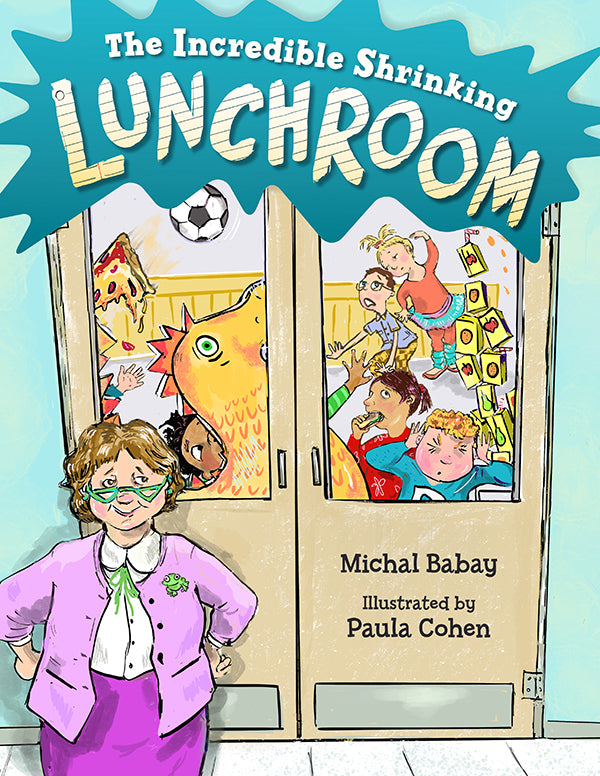The Incredible Shrinking Lunchroom

Michal Babay, author
Michal Babay is a former teacher and elementary school resource specialist who decided to follow her writing dreams. She is the author of I'm a Gluten Sniffing Service Dog and lives in California with her husband, three kids, three dogs, one cat, and a bearded dragon named Gus Pirate Potato.
Read more about Michal.
Paula Cohen, illustrator
Paula Cohen has a BFA in Illustration from Parsons School of Design and was an editorial illustrator before returning to her first love, children's books. She is the illustrator of Honey on the Page. Cohen lives in New Jersey with her family and mini schnauzer.
Read more about Paula
- Coming soon!
Kirkus Reviews
Can a principled principal help beleaguered students? The students at Parley Elementary School are fed up with their overcrowded, noisy, messy lunchroom. Soliciting help via polite correspondence with their principal, Ms. Mensch, they receive peculiar advice: Science projects should be placed on lunchroom tables; classroom pets should be brought to the lunchroom; sports teams must practice in the lunchroom. After carrying out these odd instructions—and seeing the situation deteriorate further—the desperate kids fire off another entreaty. Ever optimistic Ms. Mensch’s new solution? Projects, animals, and athletes must exit the lunchroom pronto. The result? The lunchroom is wonderfully spacious, neat, and quiet! Readers will note and appreciate that Ms. Mensch, who enjoys eating privately at her own desk, receives ample rewards in the end. The author’s note mentions that this story was inspired by a wise, witty Yiddish folktale, which serves as the basis for Margot Zemach’s It Could Always Be Worse. This book succeeds as an updated, equally humorous parable that conveys the realities of today’s schools and educators while emphasizing the moral to put life in perspective and be grateful for what one has. Children will relate to the students’ predicament and chuckle over the extremes they undergo to achieve a “fix.” The riotous digital illustrations capably match the comical shenanigans. Students are depicted diverse as to race, ethnicity, and physical ability. Ms. Mensch is light-skinned; some children wear kippot, and one child wears a patka. (This book was reviewed digitally.) Sage, farcical wisdom for lunchtime or any time.
Jewish Book Council
The classic Jewish folktale about the crowded house that becomes even more crowded when the wise rabbi suggests adding farm animals to the mix has been told in countless versions over the years, some using the traditional village setting, others a variety of unique twists. This new take on the story is set in a modern-day school building and, when the story begins, the lunchroom is packed with students. It is so crowded that it’s hard to find a place to sit and food spills on everyone and everything. The students write a letter to Mrs. Mensch, the principal, asking for a solution to the problem. Much as the sage, learned rabbi in the original tale, Mrs. Mensch has her own methods that are not apparent to the students. The science fair displays are moved to the lunchroom, the classroom pets are relocated to the tables, and the sports teams are invited in for practice. When the students complain about the overcrowding, which is even worse than before, the sports teams return outdoors, the pets to the classrooms, and the science projects to the hallways. The students can now enjoy the roomy luxury of their “new” lunchroom.
An author’s note credits one version of the story, It Could Always Be Worse by Margot Zemach, as the inspiration for this rollicking book, with its amusing, cartoon-like illustrations and straightforward yet delightful prose. Babay retells Zemach’s story, citing the positive effect it has had on her life and highlighting the Jewish concept of sameach b’chelko, or being grateful for all one has. Babay also uses the opportunity to reflect on the overcrowding in many schools and the toll this takes on dedicated teachers. She expresses the hope that the situation will improve and gives a well-deserved nod to educators who teach in overcrowded schools, emphasizing that a positive point of view goes a long way in ameliorating conditions while working for change.
This charming take on the classic story can be used by parents and teachers to promote discussion, but it is also just plain fun.
Children's Literature
Parley Elementary has the noisiest, most cluttered lunchroom in town - and possibly the world. Students are fed up with the noise and shouting at lunch time, so they write a letter to their principal, Ms. Mensch, asking for advice. The next morning, Ms. Mensch asks the students to bring their science experiments to the cafeteria, and suddenly the lunchroom is more crowded than ever before. Science projects stick out everywhere, and tempers flare. The following day, Ms. Mensch decides to move the classroom pets to the cafeteria. Soon the cafeteria is filled with snakes, tarantulas, hamsters, and worms. The students are very unhappy, and they write a string of notes to the principal. The next morning, Ms. Mensch invites all sports teams to practice in the cafeteria. Soon the entire lunchroom stinks of rotten fruit and dirty feet. Ms. Mensch receives yet another set of letters, and the following day she asks the children to clear the lunchroom of the science projects, sports events, and classroom pets. That day, the students sit quietly at lunch, laughing and telling jokes. In this retelling of a classic Yiddish folktale, young readers will learn gratitude and perspective. This timeless story will appeal to readers of all ages.
Hardcover
ISBN: 978-1-62354-294-8
E-book
ISBN: 978-1-63289-930-9
Ages: 5-8
Page count: 32
8 1/2 x 11





